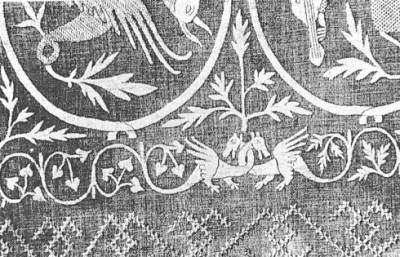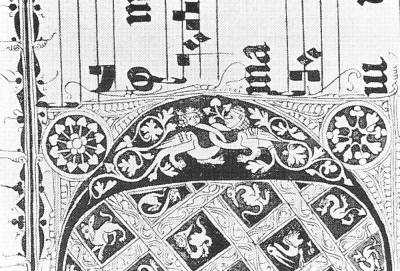
Detail of linen
embroidery, 14th c.,
Basle Historical Museum (1883/100)

Detail of
initial, Gradual of St. Katharinental, 1312,
Zürich, National Museum, MS. 128, fol. 156
| ANNE WANNER'S Textiles in History / publications |
| Linen
Embroideries from the Region of Lake Constance published in: CIETA-Bulletin No 68, 1990, p. 107 - 110, by Anne Wanner-JeanRichard |
| page 1 of 3 next |
| Influence of the upper Rhine Region |
| In November 1989
Christie's in London sold some textiles from the
former Iklé collection. There were about twenty items of
Swiss origin, including ten Swiss linen embroideries.
Swiss historical museums brought seven of them back to
Switzerland. The Textile Museum of St Gallen was one of these institutions; it was able to acquire three of the linen pieces and a silk embroidery. These acquisitions were the reason for an exhibition of linen embroideries in St Gallen in 1990 (1). These works of textile art have their origin in the region of Lake Constance, which had been a centre of linen production since the 13th century. Early examples of the 14th and 15th centuries show many links with the book illumination of the upper Rhine region, and later ones with graphic art of the 16th century in southern Germany. Thus the national borders should not be emphasized as Verena Trudel did in 1954 in her research work on linen embroidery (2). She compiled a catalogue of about 400 pieces and identified all of them as Swiss linen embroideries. The reason for this designation was that many of them bear the coats of arms of families from the German-speaking region of Switzerland. among the embroideries in Trudel's catalogue there are similarities but great differences as well. First of all they should be divided into two groups. |
The examples of the
14th and 15th centuries form a first and rather
coherent group. The format is mostly long and narrow, and
relatively few embroidery stitches were used, very often Bokhara
couching (Klosterstich). It seems that coloured
silks were also frequently used, since fragments can
often still be observed. The designs, as now preserved,
seem incomplete without the silk. A very good piece of
this first group is the embroidery from Feldbach,
14th century, today in the Basle Historical Museum.
Various animals and figures are shown in medaillons. Most
interesting is the lefthand border, which shows two
dragons with wings and interlaced long necks. Their tails
develop into tendrils with various kinds of leaves. Very
similar motifs can be found in book illumination from the
upper Rhine region in the first half of the 14th century (3). |
Detail of linen
embroidery, 14th c., |
Detail of
initial, Gradual of St. Katharinental, 1312, |
| The embroidery of Mary
and John, dating from the 15th century, belonged
to the Iklé collection and before that to the
Meyer-am-Rhyn collection. The Textile Museum of St Gallen
was able to buy it at Christie's auction in London in
November 1989. Here the design seems to be very
incomplete because the silk threads are missing. It is conceivable that the ground was covered with coloured silks as in the antependia from Engelberg, now in the Textile Museum at St Gallen, of about 1330. These embroideries were certainly made in the convent of Engelberg, and they too show the influence of the upper Rhine book illumination (4). In addition it is known from the so-called "weaving frescoes" of Constance, dating from around 1316, that silk manufacturing had been introduced into the region at that time. An inscription in Constance says: "Side spul ich ane nit" (I am spooling silk without any difficulties). |
Detail of Mary and John, 15th c., silk threads are missing |
| Upper Rhine | Golden Age | Books |
| home content | Last revised 6 August, 2004 |